Menus
- 2015 vintage
- The versatile trail
- Discovery
- In the saddle
- In the city
- Motorway and expressways
- Departmental
- Part-cycle
- Braking
- Comfort / Duo
- Consumption
- Conclusion
- Colors
- Main novelties
2015 vintage
The Versys 650, previously based rather in style on the ER6 N roadster, is now forging its own personality with the 2015 vintage. It thus joins that of its elder Versys of 1000 cm3, also reworked at the end of the year.. The verticality of the lines a little rough, gives way to more sportiness, thus joining more faithfully the Kawasaki spirit. If aesthetics are revolutionizing, the midsize also incorporates several evolutions both in ergonomics and in the cycle part. Arguments whose effectiveness we now judge on Sicilian roads.
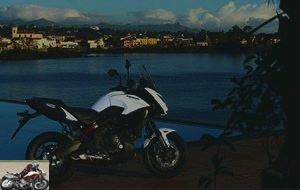
The versatile trail
From the ER6-N, the Versys has been able to convince since 2006, many bikers seduced by its ease and efficiency. Comfortable riding position, specifically reworked twin-cylinder and a little more protective fairing, the midsize road trail knew how to speak to everyday pilots. If the first vintages presented a specific design, even a little ungrateful for some, they then evolved towards a more pleasant aesthetic, again following that of the roadster. Likewise, its displacement increased to 649 cc.
The 2015 vintage breaks, to say the least, with the original genetics to become more affiliated with that of the Hakashi firm. In addition, the many other evolutions, both at the mechanical level and part cycle, come to optimize its capacities of small road. A 160 km journey on the Sicilian coast, around Catania, will allow us to better understand the Versys 650.
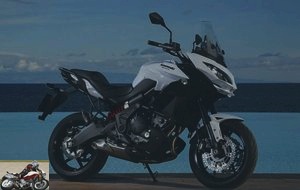
Discovery
The 2015 vintage is a major overhaul, the obvious external sign of which hides many others. No more verticality of superimposed front lights. The tapered optics find the horizontal, surmounted by a windshield sliding 60 mm, after unlocking two knobs. Sharp, the fork crown adopts an aerodynamic profile also optimizing the management of air flows. The angular lines of the frontal surfaces combine to trap air flows, then framed by side deflectors. This new style helps to reinforce the belonging to the road family defined by the Z1000 SX. Long scoops surround the radiator and extend their volume by elements running on the 21-liter tank (19 previously).
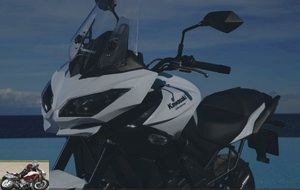
We then notice an attractive one-piece saddle, placed on a reinforced rear frame, nicely sheathed tubular structure. More resistant, it allows to carry more weight but weighs down the machine by 8 kg for a total of 214 kg (216 with ABS). Surrounding the seat, new high-quality grab handles now integrate the luggage racks. Their surface also has lugs, complementing those of the passenger footrest plates. Slender, this rear shell is concluded with a LED light with a dynamic design.
Unchanged, the diamond-like tubular steel frame supports the 649 cc parallel twin cylinder with two ACT and 8 valves. The block benefits from new silent-blocks at its front mountings, in order to reduce vibrations. Its bore-stroke ratio does not change (83×60 mm), but the twin delivers 69 horsepower (+ 5 hp) at 8,500 rpm (500 rpm higher) and 6.4 da.Nm (+0.3) at 7,000 revolutions / minute (200 revolutions higher). Merit goes to the mapping and the double butterfly injection, further optimizing the low and medium revs and compensating for the excess weight.
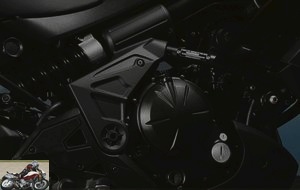
Hidden by a large shoe, split into two parts, the collectors flow into the silencer still placed under the machine, compacting the machine. At its side, we appreciate the design of the aluminum swing arm, banana type, made up of multiple elements with discreet welds. Its movements are entrusted to a Kayaba lateral mono-shock absorber, adjustable in preload by a remote dial. A new 41mm Showa inverted fork is fitted to the front axle. The tubes are 25 mm longer (20 mm at the rear) but the travel does not change, only optimizing the work of the suspension. Here too, you can adjust the preload on the right tube but also the rebound on the left, by knobs placed on the tops of the fork tubes..
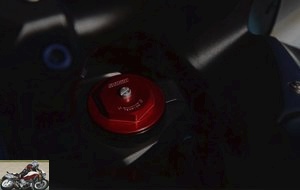
The (long) list of improvements also relates to braking, with an improved brake master cylinder and the adoption of new Nissin calipers (previously Tokico). The clamps of the steering gear, with double pistons, bite 300 mm petal discs. The rear element, a single piston, clamps a 250 mm petal cake. Smaller, a Bosch 9.1 MP ABS control unit monitors the action of the retarders on the 17-inch wheels. The six-spoke rims are fitted with Dunlop D 222 to the road profile.
The finish of the whole is particularly rewarding. Neatly coated engine casings, inserts protecting the pilot footrest plates, architectural plastic cover covering the sides and frame, hidden cables and hoses…. the Versys 650 doesn’t skimp on aesthetics. Evidenced by his new face. This break in style may disappoint fans from the start, but it turns out to be successful.
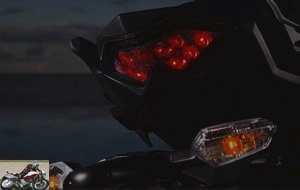
However, we fall into a new trap, this time affecting more the 650 than the 1000. If the sharp watermelon of this new face is well suited to the four-cylinder trail, it makes the midsize a little heavier. With light colors where the contrast is stronger, the fork crown seems to float heavily on the steering gear because of the dark side scoops and deflector.
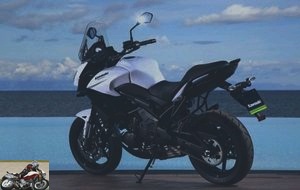
In the saddle
Even more accessible with a saddle at 840 mm (- 5 mm), the Versys is especially narrow at the crotch, making it easier to rest on the ground for the less tall. The seat is particularly comfortable and the ergonomics are devoted to long-term ease. Extended by 20 mm and lowered by 15 units, the rider footrests reduce leg flexion. The handlebars, attached to high saddles, are also brought back to the cockpit, allowing the hands to naturally grip the handles. All these supports are mounted on silent-blocks in order to drive out the trepidations. Finally, the levers are adjustable in spacings.
Superior yoke with a pleasant surface and top of the fork tubes in red aluminum contrast with taped cable passages and a little messy fork then. A little more fairing and integration would have been preferable. The large cockpit enhances the Versys and contains an unchanged instrument block. There is an analog tachometer dominating a (too) small digital window. There are tachometer, fuel gauge, odometer, two partials, instantaneous or average consumption and clock. An "eco" light appears when your driving preserves fuel consumption.

We regret the absence of control on the handlebars, forcing to plunge the arm towards one of the small buttons of the panel and the absence of a central stand as standard. Our over-equipped testing machines also include hand guards, heated grips adjustable on 6 levels and additional projectors. Suitcases of good bills also flank our frames.
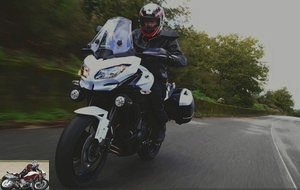
In the city
At idle, the parallel twin produces a discreet syncopated melody, but quickly makes a more pleasant rumble as it revs up. Knocking under the 2000 revolutions per minute, the unit however supports without too much difficulty the urban evolutions on the intermediate reports. Especially since, flexible clutch lever coupled with a soft and precise selection, make the Versys appreciable between the walls. The rearview is also very correct.
Particularly alert, the twin-cylinder does not lack life. If necessary, he then dynamically restarts the mount, however generating a slight jerk on the go-around.
Precise and agile, the Kawa is easily placed in traffic, its wide arch hovering over the mirrors. However, its front axle seems to present a certain inertia when maneuvering at low speed, probably attributable to the profile of its tire, which is fairly round and the height of its fork. Not enough to detract from its ease, its turning radius allowing it to effortlessly turn around. We will pay more attention, if we have fixed the suitcases, to their size. Wider than the ends of the handlebars, they could play tricks on the crew. In any case, if the trail midsize willingly bends to urbanities, it has much better to reveal when setting off..

Motorway and expressways
Very voluntary, the twin quickly takes the machine at unusual speeds. At 190 km / h (9000 rpm) and with the suitcases, the course is remarkable. At legal speed, the Japanese block turns at 6,000 rpm, at 7,000 for 150 km / h, reviving the crew at will, at the best of its torque curve. Whatever the speed, the mirrors remain clear, no annoying vibrations interfering with the mirrors or, for that matter, handlebars and footrests. The new silent blocks make the difference.
And comfort is worked on on other essential points. Bubble in the high position, only the top of the helmet and the end of the shoulders then undergo a few assaults from the air flows. No need to bow down for the older ones. As for the saddle, its comfort makes you forget the kilometers. For the most delicate, a comfortable seat is still available, but hardly essential in my opinion. Especially since the suspensions effectively filter the defects of the bitumen.
Mechanics and ergonomics make you want to ride far and long, without apprehension. These excellent road skills are revealed even more outside the tariffed network..
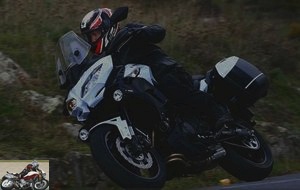
Departmental
Stroll on the torque or wind at a good pace, the Kawasaki Versys 650 brings the same pleasure to your journeys. If the slight increase in engine life cannot be assessed, the twin is anyway quite playful to boost journeys. If it does not show notable exuberance, its wide availability effectively accompanies its cycle part. Tractor from 5,000 rpm, it expresses itself fully 2,000 revolutions higher and does not lower its effort until 1,000 revolutions before the red zone. So we don’t knit too much with the selector, at least solo. Two and loaded, the block will need to be a little more whipped and maintained in the towers.
Favoring comfort by default, the steering gear can be increased in preload and braked rebound, to limit mass transfers and gain in precision in dynamic steering. We then enter more easily on the brakes in curves and the trail follows the gaze effortlessly. The shock absorber works in concert with the fork and calmly collects holes and bumps.
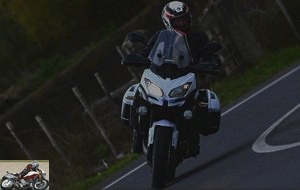
With its wide handlebars and low weight, the Versys easily swings from one angle to another, also taking advantage of a very correct ground clearance. The machine does not move on the angle and accepts course corrections without complaining. We just regret a slight lack of feeling from the front tire, for the reasons already mentioned. Not enough to slow down the pace, the Kawa being easy on all occasions. In discovery piloting, we retain this ease and especially its comfort at all times. The machine is forgotten to give free rein to the journey, letting the crew enjoy their journey.
Powerful and very progressive, the Nissin front calipers deliver frank decelerations but make the bike dive quite significantly. On the angle, the steering barely locks when taking the levers. The rear opposite element does not provide the same pleasure despite the improvements made. The pedal stroke is long and the feeling is quite diffuse. However, this retarder accompanies its counterpart to ensure the passages in curves. Efficient and discreet, ABS calls for no comment.
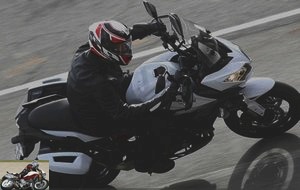
Part-cycle
Simple but effective, the cycle part of the small trail matches its vocation as an economical road. Without sacrificing the altar of low cost, evidenced by its adjustable suspensions. Stable, agile and with excellent heading stability, the whole is homogeneous.
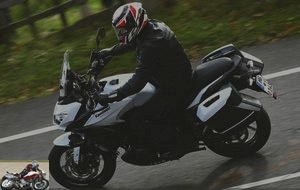
Braking
The new calipers are convincing and stop the Versys rigorously. The feeling of the elements of the steering gear is more pleasant than the rear clamp but the whole is of good quality.
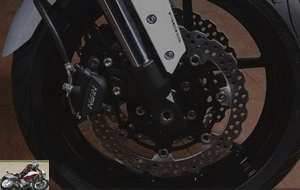
Comfort / Duo
THE strong point of the Versys lies in its welcoming qualities for the crew. Convenient ergonomics, comfortable saddle, the Kawasaki invites you to travel, alone or in pairs. Its easily adjustable suspensions are also an asset, as are the generous grab handles. The qualitative luggage will take 28 liters per suitcase and 47 liters in the top case. Enough to house helmets and
layette.

Consumption
The twin is as sober as it is voluntary. With 5.3 liters on average over the test, it is easy to imagine going below this value. Stages of more than 350 km are therefore possible, without saving the pleasure..
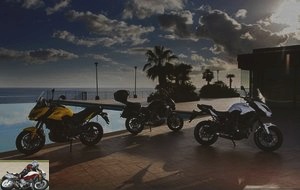
Conclusion
Surprising and convincing, the new Kawasaki Versys 650 seduces as much by its manufacturing qualities as its dynamic performances. Over the kilometers, ease and docility combine with the pleasure of its twin. Its new aesthetic also gives it an increase in personality and sportiness. Maybe a little too much. However, it is difficult to find other weak points in view of its competitive price: € 7,299 and € 7,699 with ABS. It’s better and at the same price as the previous version !
We will oppose him the Suzuki V-Strom 650 ABS, priced 7,999 €. Its V-twin wedged at 90 ° is particularly lively and the machine powerful but a little behind in terms of finish. Another possible competitor, the Yamaha XT660Z Tenere ABS, asking for € 7,799. Less attractive for the duo, less efficient but easier to get out of the bitumen.
Representing a homogeneous and rewarding whole, the Kawasaki Versys 650 will seduce on a daily basis and on distant trips, in the city as in the countryside, solo or duo. Versatile in every way, the 650 Versys lives up to its name.
Strong points
- Engine character and availability
- Agility of the chassis
- Comfort and protection
- Finishes
Weak points
- Aesthetic ?
The Versys 650 technical sheet
Colors
- White Pearl Stardust
- Black Metallic Spark / Black Flat Ebony
- Pearl Shining Yellow
Main novelties
- Covering revised for better protection
- More powerful engine at high revs
- Showa inverted fork with separate functions
- Braking revised
- 21 liter tank
- New luggage rack system
- Increased payload
Related articles
-
Sport sofa Unveiled in 2011, the first version of the Z1000 trail set new milestones in a segment that was already well represented. The first machine of…
-
Kawasaki Versys 650 motorcycle test
Twin-cylinder 649 cc, 69 hp, 210 kilos, A2 version, euro5 ready Daily test 2006, the year of the successive revivals of Kawasaki on segments where we…
-
Kawasaki VN 1700 Voyager Custom ABS review
Kawa makes the clone …. With her very sleek lowered silhouette and plethora of equipment, this slanted-eyed American is largely inspired by the Harley…
-
40 horses at 11,500 rpm 25.7 Nm, 175 kilos with full tank, two colors, € 5,799 An easy and sparkling little trail: what if life on a motorcycle was as…
-
TGV first class Five years ago, Kawasaki presented its first Z1000SX, a road version of its Z 1000 reference roadster. A versatile machine, which has…
-
Evolution Like few models, the Z can boast of having built a first name within its own brand. After eight years of hegemony in the flagship motorcycle…
-
Closely derived from competition, the Kawasaki KX 250 F and KX 450 F combine innovations and off-road performance. Struggling at the best level, they are…
-
Kawasaki Versys 1000 motorcycle test
La Z goes green Eternal absent from the Kawasaki range, apart from the unlikely KLV 1000 (Suzuki V-Str m renamed), the maxi-trail model finally appears…
-
Custom for all ! This Kawasaki hides its game well. Under its air of custom for young license, the Vulcan S is actually a fake roadster with a sparkling…
-
Kawasaki Versys 1000 SE motorcycle test
3rd evolution for the shock road trail hybrid 4 cylinders in line, 1,043 cm3, 120 hp and 102 Nm, KECS electronic suspensions, 257 kg, 16,899 euros…
being myself owner of a Thruxton 1200, I am only surprised by the prices announced in the test.
The standard is 13,800 euros, the R is 16,100 euros and the RS is indeed 16,700.
No Thruxton at 14800 as advertised in the test. Suddenly, the difference between the R and the RS is "only" of 600 euros, which taking into account the stated differences between the 2 models does not seem so funny to me..
Please pay attention gentlemen testers to the information you announce.
Because suddenly it changes everything !
Otherwise test at the top …
Chris> the R was € 14,900 when it was released, I think that’s what the journalist meant .
.
And that’s exactly what is written in terms of price.
Thank you fift
Yes, in our opinion, the rims allow tubeless tires. I still ask the development manager for confirmation..
The Thruxton is of course two-seater homologated but, as also indicated, saddle and footrest are optional. And it’s very mean.
The Brembo M4.32 didn’t bother us at all in 2016. The M50s are great but really not useful in absolute terms. A 2020 Kawasaki Z900 has non-radial calipers … and it brakes very well with an excellent feeling.
The Thruxton RS is a fabulous authentic feel machine. But clearly too expensive in our opinion.
Waboo> the M4.32 are very very good … with new pads.
The initial assembly is very sensitive to the centering of the calipers, and wears the pads in a strongly asymmetric way, which ends up causing a rather unpleasant 2-step braking: first the handle is soft (the first pad sticks), I release and immediately picks up the handle: it becomes hard again as it was originally (the second plate is in contact).
To fix that, you can play a little with the attack stroke of the master cylinder piston, or go to a dealership to re-center the calipers … after each tire change.
Ah yes ? Not glop.
that, of course, we can’t see it alas…
Thank you fift.
Hence the change for the M50s …
This is why I provide these details, invisible during the test.
I’ll join you on the fork too: when driving hard, it is better to tighten up a notch in compression AND rebound. If you release the brakes sharply to the angle with the original setting, the fork slackens suddenly, lifting the bike up. But hey, you still have to go hard .
.
For the shock absorber, on the contrary, I would tend to close the hydraulics in compression. Also in sporty riding, the bike tends to pack down when accelerating to the angle. Not very annoying but it reduces the ground clearance and you finally rub quite easily if you do not sway (yes, yes, I know, the AFDM position, all that ).
).
For comfort, obviously it’s less good but after 10 years of Ducati, what do you want, we have habits …
Yes, I would tend to say that the journalist / test settings are sometimes different from the production bikes. History of muddling the waters.
For us, the fork is a bit soft, but it was especially the rear combinations that were of concern. And not by settling down …
This machine is really not bad.
The new aesthetic is still better !
On the other hand, one thing escapes me a little with these new machines:
what is this mania to put a huge windshield like that ?
A real scooter "pie shovel".
Soon, among props: small bubble.

For those who don’t mind the wind, on the contrary.
TO+
Eljeh
Unbearable from Triumph.
Ducati had made very beautiful radiated rims on its Sport Classic 10 years ago. !
How can we now offer chamber tires on a road motorcycle ???
Well there it is, inadmissible! I am waiting to see what will become of the Speed Twin with a change of the engine to Euro 5, maybe a Speed Twin rs?
Hey, that reminds me, I just found an old magazine that says the R1100GS (it’s a bit dated) has tubeless cross-spoke rims…
And there, it’s been more than ten years.
Logically the speed twin will inherit
Of this engine and with its stick rims
No more inner tube problems …
In 1985 the 600 XLLM had tubeless spoked rims.
And you don’t need sick technology to make it happen, just waterproof spoke heads. It’s within the reach of Triumph, no ?
Now, there are some who will put X hundreds of euros in alakon options such as kiprout exhaust, mini turn signals or "the little chrome screw, there", while for 400 balls including postage, you can convert your rims to tubeless spokes:
[www.evo-xracing.com]
I am interested in you, the Iguana! I had asked at Triumph, it was 500 € by rim.
Suddenly I had let it fall.
You just have to leave the Thrux on holds in the street for a few days
[attachment 32677 pu1.jpg]
Yes I realized it by reading the pdf more carefully .
.
She will stay with the inner tubes, it’s not so bad after all the inner tubes
I confirm all the points of the test!
The only criticism I will make with this bike is its lack of personality. It is good in all areas, but very good in none, and what makes the charm are the small imperfections…
Shell in the teaser of the article (the one we see on the home page and in the RSS feeds): "141 kilos and almost 270 kilos" instead of "141 horses …"
It’s corrected, thank you!
It is a machine that would not suit me, but that I find quite well designed and successful!
Hello
Take a big road, raise the suspensions, and it gives that.
The circle is complete.
By dint of roading the "trail" by adding a big mill, we arrive at crazy weights and we leave the real trail.
There is no mystery…
(And this is valid for all big trails).
Reservoir 20 liters of capacity, it is the minimum for this type of motorcycle! I was afraid that they would announce 15 liters as on the gs 850.
But hey, we need it for everyone.
It is not made for the all-terrain! It’s just to pretend …
I do not understand the placement of this motorcycle compared to the Tiger sport.
25 kg more, + 15 hp but € 7,000 more +.
A part is justified with the equipment but apart from wanting to attract the few disappointed BMs I do not see the target …
Thank you for these comments and sorry for the late response, just time to come back from Almeria.
So, in order:
– @ Diko: thank you !
– @ Tempo: you are not wrong about everything, but there are two differences: a big trail remains less heavy than a big GT and the geometry (hunting angles and all the noise) will always make it more obvious to carry on small bumpy roads or in difficult conditions. And this, for a comfort that is not much behind. This is what makes the strength of big trails, if you want my opinion…
– @ Diko: well so! Besides, we had a second day of testing, only off-road, with an XC with the right tires. Test soon on Le Repaire…
– @OlivierZX: there is still a big difference in road approval, quality of suspensions and endowment. The 1050 is nice, but it’s an old bike that has been updated several times. The 1200 is very modern in its design and its equipment (dashboard, cruise control, active suspensions, electric bubble and so on) has nothing to do with it. Let’s not forget that a clientele is sensitive to these arguments…
Thank you for following us in any case,
Philippe